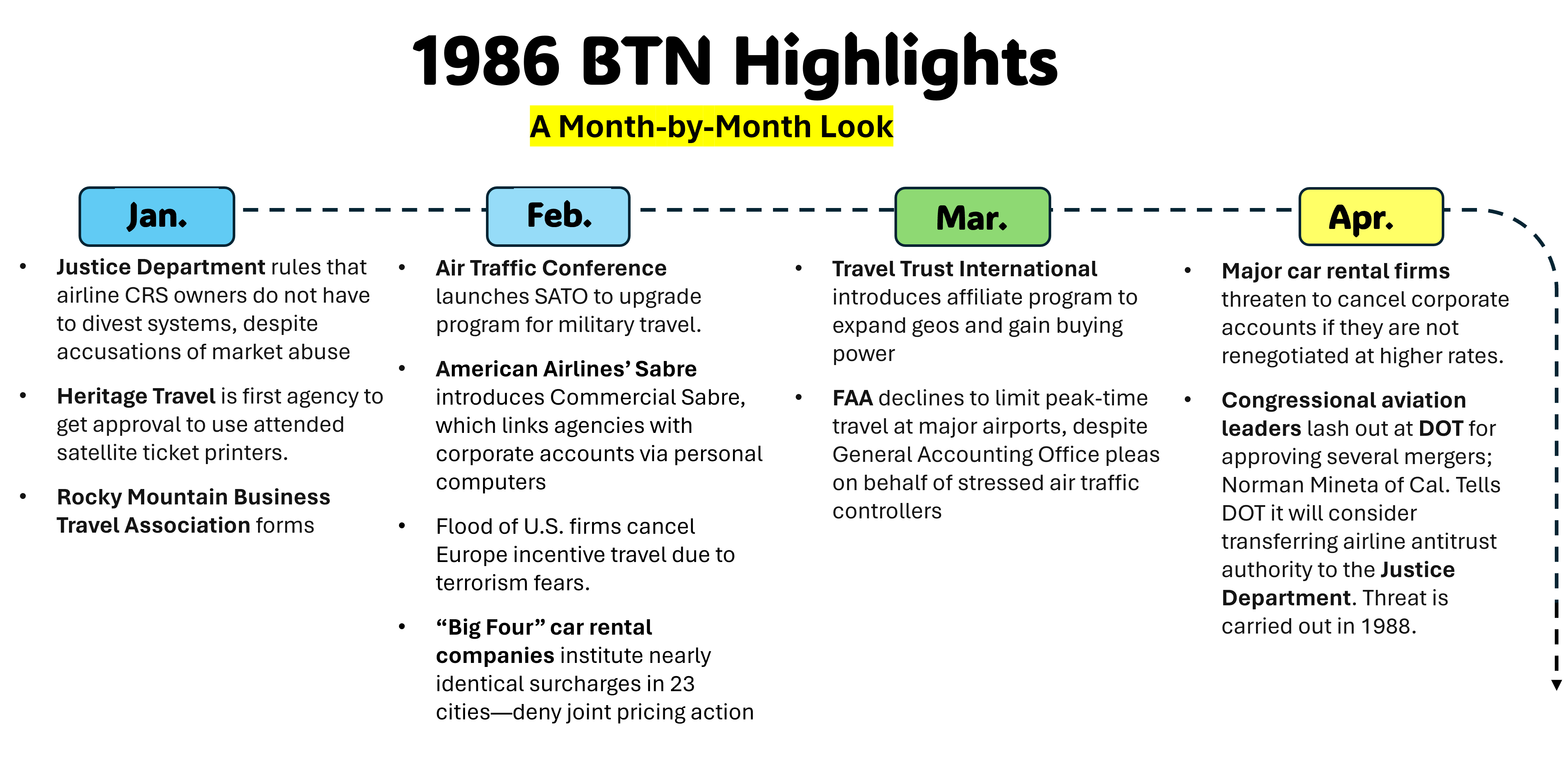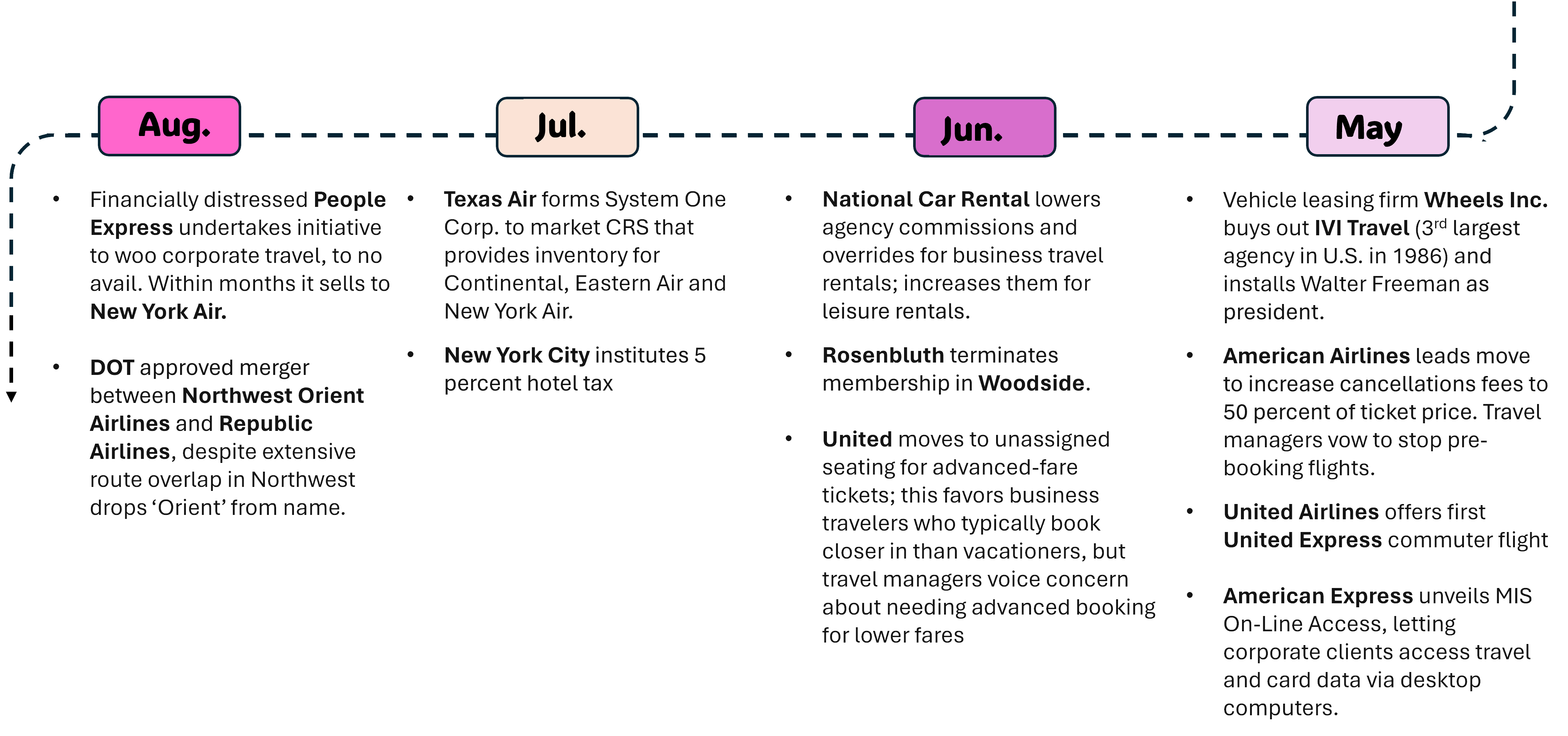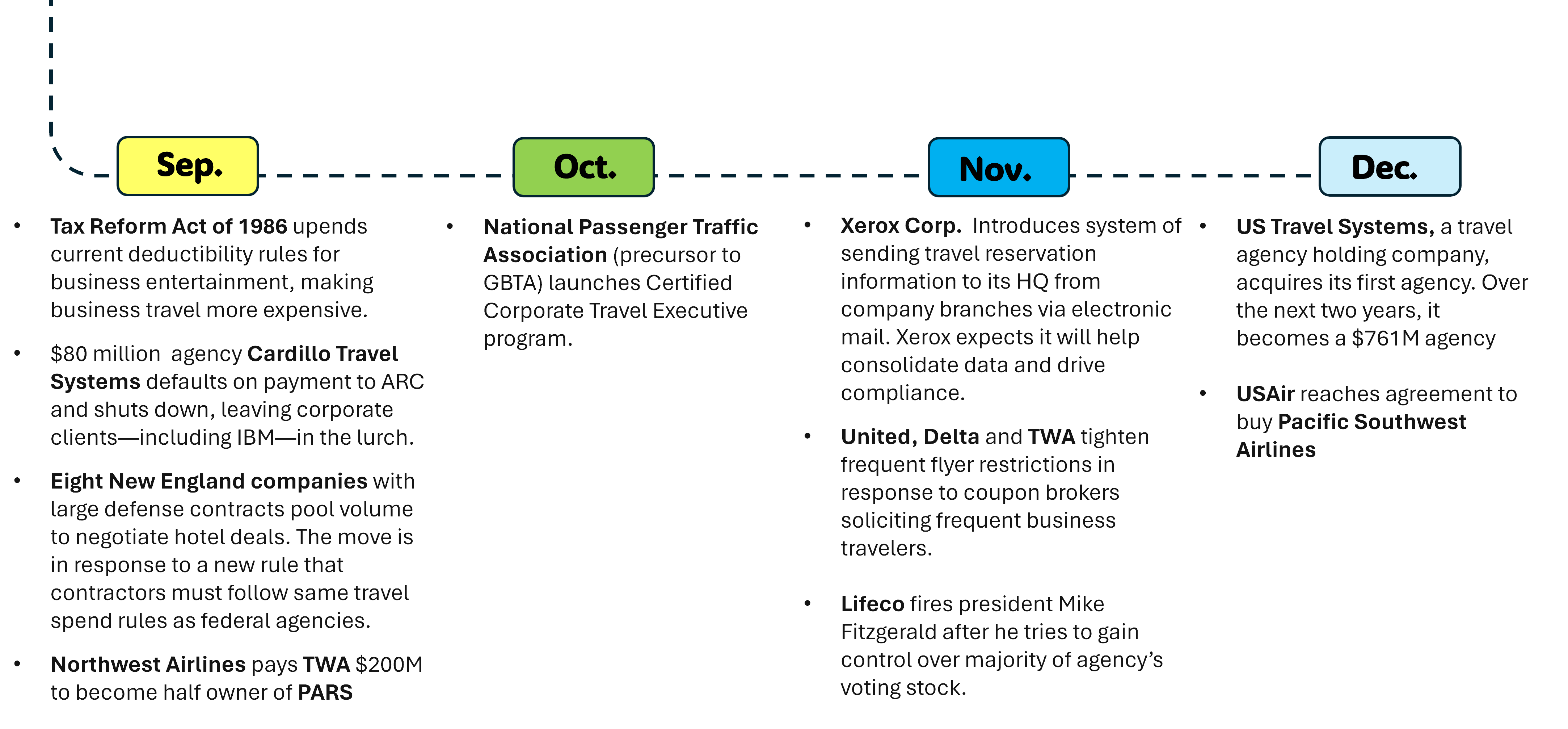Travel
Airline Merger Spree in ’86 Took Toll on Travelers

Thank you to 1987 BTN intrepid reporter Barbara Cook for the
original article excerpted below. This article appeared in BTN’s 1987 Business
Travel Survey, which is a summation of the previous year’s business travel
industry activities. This article focuses largely on air travel, the mergers
taking place in the industry in 1986 and rapidly rising consumer complaints regarding
on-time performance and services. At the time, the U.S. Department of Transportation
handled M&A inquiries. After a rash of mergers and acquisitions put through
in ’86, Congress threw the book at the DOT for not protecting consumer interests.
It eventually shifted responsibility for M&A antitrust investigations to
the U.S. Department of Justice—which is where it still lives today.
Under the
Trump Administration, airline M&A deals and deep operational partnerships were
largely waved through; the Biden Administration has been much more hawkish on antitrust,
and has scuttled a number of recent airline deals, particularly those broached
by JetBlue.
BTN is certainly still reporting on the prevalence of
airline delays and cancellations. We have recently covered specific penalties
for Southwest Airlines winter 2022 systemwide issues and, more generally,
DOT taking consumer protection action on issues like ancillary
fee disclosures.
_________________________________________________________________________
Take a look at where we stood in 1986… compliments of Ms.
Cook. The timeline that weaves through this article gives you a bigger picture of what happened in the business travel industry that year. For a literal bigger picture, just click on the images!
The nation’s airlines had a heyday in 1986 gobbling up other
carriers and realigning their operations—moves that took their toll on business
travelers.
In the frenzy to capture market share, carriers probed every
possible combination of route and fare strategy. Often, the strategies led to
mergers—of which the Department of Transportation approved 12 during 1986.
When financial results were tabulated, the carriers s a
group lost $169.4 million in 1986, a total dragged down by heavy losses at
People Express Airlines Inc. and Pan American World Airways. Excluding those
two carriers, the group had a profit of $538.7 million.

Consumer complaints to the Department of Transportation
about airline service rose steeply in 1986—up 30 percent over the previous
year.
Flight cancellations and delays led the list of consumer
complaints, with World Airways and People Express the prime culprits, according
to the DOT. Other carriers heading the list of complaints were Pan Am, New York
Air, Trans World Airlines, Continental Airlines, Jet America, Hawaiian Air, Northwest
Airlines and United Airlines.
The Federal Aviation Administration came under heavy
congressional pressure during 1986 to find ways to reduce mounting flight
delays, of which 417,644—more than 1,144—were reported.
The FAA in the spring moderated airline scheduling talks
that resulted in some peak-time flight adjustments, but industry officials warn
the expected added capacity for the summer season could well offset any gains
produced by the scheduling talks.
…

As dissatisfaction with airlines service grows, the carriers
face possible action from the DOT and Congress.
…
Many legislators have been outspoken for months about what
they view as inadequacies in airline service and the mounting problem with
flight delays. Several bills have been introduced relating to the situation.
In his bill of rights for airline travelers, Sen. Howard
Metzenbaum (D-Ohio) said the DOT has viewed its aviation responsibilities in
the context of approving huge airline mergers rather than protecting the traveling
public.
Metzenbaum’s bill would require the DOT to establish disclosure
regulations ensuring that the airlines inform each ticket buyer of the line’s
policy on flight cancellations, delays, overbooking and liability for lost or
damaged luggage.
Further, the legislation would require the publication on a
regular basis of each carrier’s total of delayed takeoffs and arrivals; the
number of flight cancellations; the number of rerouted and downgraded flights;
and the number of passengers bumped from flights and the treatment accorded
these passengers.

Sensing that airline consumer protection legislation could
well be enacted this year [1987], some carriers have volunteered to provide the
DOT and the public with information on flight delays, damaged and lost baggage,
and fare availability.
[Editor’s note: Much of this information today is available
on the DOT website,
which BTN reporters often find helpful. We also get such data from Cirium and Flighttracker.]
On the plus side for airline travelers during 1986, the
widespread availability of discount fares
saved passengers more than $3 billion, according to the Air Transport
Association. The ATA said 90 percent of
all passengers used some form of reduced fares last year, with the average
discount being 60 percent. [Note: The original article does not substantiate
this with a metric or formula of how this was calculated.]
A Gallup Organization poll of air travelers showed that 54
million adults took airline trips during the year, compared with 48 million in
1985. The survey found that 46 percent of those airline trips were for
business, and the average air traveler made 3.2 round trips.
As 1987 began, airline analysts were predicting that fewer discounts
would be offered this year, pointing out that carriers would strive to improve
yield management.
…
On the other hand, Eastern Airlines in early April launched the
BusinessSavers program from its Atlanta hub, a variation of MaxSavers [leisure
fares] that carries only a 30 percent discount. The BusinessSaver rates allow
the exchange of unused tickets—unlike MaxSavers—but still no cash refunds.
___________________________________________________________

Elizabeth West is the editorial director of the
BTN Group. She has reported on the business travel and meetings industries for
24 years. Beth was editor-in-chief of Meeting News from 2006 to 2008 and
director of content solutions for ProMedia Travel from 2008 to 2011, when
ProMedia was acquired by Northstar Travel Media and merged with BTN. She became
editor-in-chief of BTN in 2015 and editorial director of the BTN Group in
2019.
__________________________________________________________________________
Credit: BTN recreated this timeline in this article from a list of industry
events compiled by editors of BTN’s 1989 fifth anniversary retrospective: Jim
Alkon, Jeanette Borzo, Judi Bredemeier, Mary Brisson, Barbara Cook, Richard
D’Ambrosio, Shann Davies, Larry Kilman, David McCann, Laura Koss, Don Munro,
Imitiaz Muqbil, Jody Oesterreicher, Magdalene Ruzza. Thanks guys!







:max_bytes(150000):strip_icc()/roundup-writereditor-loved-deals-tout-f5de51f85de145b2b1eb99cdb7b6cb84.jpg)


